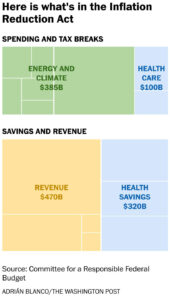JULY 28, 2022

Major changes to the Affordable Care Act. The nation’s biggest-ever climate bill. The largest tax hike on corporations in decades. And dozens of lesser-known provisions that will affect millions of Americans.
If enacted, the legislation released Wednesday night in a surprise agreement between Sen. Joe Manchin III (D-W.Va.) and Senate Majority Leader Charles E. Schumer (D-N.Y.) would represent one of the most consequential pieces of economic policy in recent U.S. history — though still far smaller than the $3 trillion the Biden administration initially sought.
The nonpartisan Committee for a Responsible Federal Budget estimates that the bill would put about $385 billion into combating climate change and bolstering U.S. energy production through changes that would encourage nearly the whole economy to cut carbon emissions. With the planet rapidly warming, Schumer and Manchin say the bill would reduce carbon emissions by roughly 40 percent by 2030, close to President Biden’s goal of cutting U.S. emissions by at least 50 to 52 percent below 2005 levels by 2030. Manchin also emphasized that it would spur American energy independence more broadly, including by encouraging natural gas, as the war in Ukraine has exposed domestic reliance on petrostates’ fossil fuel production.
The bill uses two main levers: major new incentives for private industry to produce far more renewable energy, and other incentives for households to transform their energy use and consumption. Democrats say this second set of incentives will also offer immediate consumer relief for the higher energy prices that have bedeviled the Biden administration.
The agreement would also raise roughly $470 billion through new tax provisions, the budget group estimates — the biggest of which will fall on the country’s large corporations. After years of rising concern about widening wealth inequality, Democrats failed in their efforts to repeal Republicans’ 2017 tax law. The new bill leaves intact most of the corporate and individual income tax cuts President Donald Trump signed into law, largely because Sen. Kyrsten Sinema (D-Ariz.) had insisted on leaving them untouched.
But it would still raise taxes significantly, and it would give the badly underfunded Internal Revenue Service its biggest budget increase in its history.
“This would certainly be the biggest corporate tax increase in decades,” said Steve Wamhoff, a tax expert at Institute on Taxation and Economic Policy, a left-leaning think tank. “We’ve had decades of tax policy benefiting the rich, but this is really the first attempt to raise revenue in a progressive way that would begin to combat wealth and income inequality.”
On health care, Democrats campaigned in 2020 on major changes, and this deal fulfills two major pledges: Allowing Medicare to negotiate the price of prescription drugs, and making health care more affordable for millions of Americans.
It falls short on plugging one of the biggest gaps of the Affordable Care Act and other key items long sought by the party’s more liberal members. Still, it amounts to the biggest changes to the health system in roughly a decade.
“This is the best development on health care for the American people in years,” Sara Lonardo, a spokeswoman for Families USA, a liberal consumer health lobby, said in a statement. “It’s crucial we get this deal locked down and passed as soon as possible. Once this bill is law, we will keep fighting to ensure the millions of Americans in the Medicaid coverage gap get the care they need to live their healthiest lives.”
The bill leaves out many key policy ambitions of Democrats — excluding, for instance, plans for new child care, housing, eldercare and paid-leave programs. But after months of gridlock and false starts, Democrats hope this agreement will finally become law.
Meanwhile, Republicans have started warning that the measure will hurt the U.S. economy with higher taxes as fears of a recession are growing. Steve Miran, who served as a senior official in the Treasury Department under President Donald Trump’s administration and is the co-founder of the investment fund Amberwave Partners, said the plan’s tax provisions would exacerbate inflation by leading to a decline in supply. “The current policy mix has already messed up the supply side, and hiking taxes will push further in the wrong direction,” Miran said. “In a world where demand outstrips supply and causes inflation, I don’t think attacking supply even further is the solution you’re looking for.”
But Democrats from Biden on down argued that the deal was a big step forward.
“If it sticks, this will be a huge policy win for the White House and the country, addressing both the president’s number-one short-run issue of inflation, and the number-one long-run issue: climate change,” said Jason Furman, who served as a senior economist in the Obama administration.
Here is a summary of what’s in the more than 700-page bill, according to Senate Democratic officials — and what’s not.
1. $260 billion in clean-energy tax credits

New and extended credits will incentivize solar, wind, hydropower and other sources of renewable energy. Private firms and publicly owned utilities could get tax subsidies both for the production of renewable energy and for manufacturing a specific part essential to a renewable project, such as wind turbines or solar panels. The goal? To make new green energy production cheaper for utilities to build than fossil fuel plants are.
2. $80 billion in new rebates for electric vehicles, green energy at home and more

General Motors worker Kim Fuhr charges a Chevrolet Bolt at an assembly plant in Lake Orion, Mich., last year. – Nic Antaya/TWP
Buyers of new electric vehicles would get a $7,500 tax credit applied at the point of sale . That would also apply to vehicles whose manufacturers are no longer eligible for an existing EV credit, such as Tesla and General Motors. Couples who earn less than $300,000 a year or individuals who earn less than $150,000 would be eligible. A new $4,000 tax credit would also apply to purchases of used EVs. Tens of millions of people would qualify for these credits. Other consumer rebates would subsidize the installation of more-efficient heat pumps, solar panels and more.
If consumers claim the subsidies in the bill, they could save as much as $1,840 on their annual energy bill on average, according to an analysis by Rewiring America, a climate analysis group. (That would also require spending significantly to buy things such as an EV, a heat pump and solar panels.) That’s also the case for the latest agreement between Schumer and Manchin, said Leah Stokes, a climate expert at the University of California at Santa Barbara.
3. $1.5 billion in rewards for cutting methane emissions

A flare burns off methane and other hydrocarbons in Midland, Tex., in 20231. – David Goldman/AP
A new Methane Emissions Reduction Program would reward oil and gas companies that slash their emissions of methane and penalize those that don’t. The program, crafted by Senate Environment and Public Works Chair Thomas R. Carper (D-Del.), originally would have provided $775 million upfront to oil and gas companies to cut their methane emissions. The current agreement doubles that money to $1.5 billion, according to a Senate Democratic aide. Methane traps far more heat in the atmosphere than carbon dioxide, the most abundant greenhouse gas.
4. $27 billion ‘green bank’

Emissions rise from the Kentucky Utilities Co. Ghent generating station in Ghent, Kentucky. – Luke Sharrett/Bloomberg
A Clean Energy and Sustainability Accelerator, commonly referred to as a green bank, would leverage public and private funds to invest in clean-energy technologies and infrastructure. In states where green banks have already been established, public money has been used to leverage six to 20 times more dollars in private investment in clean energy.
5. Support for fossil fuel projects

A platform in the Gulf of Mexico. (Luke Sharrett/Bloomberg News)
To secure Manchin’s vote, Democratic leadership pledged to mandate new oil and gas leasing in the Gulf of Mexico and off the coast of Alaska, where industry groups are pushing for a major expansion in oil production. Manchin views drilling in those areas as important for the country’s domestic energy independence.
Manchin also said in a statement that Biden, Schumer and House Speaker Nancy Pelosi (D-Calif.) had “committed to advancing” a permitting reform bill that would make it easier for developers to override environmental objections when building pipelines, natural gas export facilities and other energy infrastructure. This falls outside the rules of the Senate procedure the party is using to pass the economic package, meaning Democratic leadership will have to try to secure GOP support for the permitting changes.
6. Agriculture, steel, ports and more

A worker irrigates a cotton field in Marana, Ariz., last year. – Matt McClain/TWP
The bill contains numerous smaller measures aimed at specific parts of the economy with high emissions: $20 billion for agriculture subsidies to help farmers reduce emissions, $6 billion to reduce emissions in chemical, steel and cement plants, and $3 billion to reduce air pollution at ports.
7. $313 billion from a 15 percent corporate minimum tax

News Electric delivery vans sit parked outside a logistics warehouse in Chicago this month. – Jamie Kelter Davis/Bloomberg
The single biggest tax hike in the plan would apply to all U.S. corporations that earn more than $1 billion per year in profits. Under current law, U.S. corporations ostensibly pay a 21 percent tax rate. But dozens of Fortune 500 companies pay no federal income tax at all by claiming deductions for research and development and other credits.
The plan would close off that option by subjecting large corporations to a tax on their financial statements. Corporations would still be able to claim tax credits, though, since renewable energy groups raised concerns the minimum tax could undercut the effectiveness of the climate tax credits.
8. $124 billion from major enforcement increases at the IRS

Margaret Moore, an IRS clerk, searches through taxpayer documents in Austin in June. – Matthew Busch/TWP
The IRS would scale up dramatically in an attempt to close the “tax gap” — the difference between what people and corporations owe and what they actually pay. Democrats say that their plan to invest $80 billion in the IRS would more than pay for itself, in part because the tax agency’s budget was cut by 20 percent between 2010 and 2020. Former IRS commissioner Charles Rossotti and current Treasury official Natasha Sarin previously estimated the IRS could raise $1.4 trillion in additional tax revenue with more funding.
While Democrats are celebrating the measure, Republicans say it represents a political vulnerability for the administration if more Americans face audits or other scrutiny from the tax collector. It remains to be seen whether all the new revenue Democrats hope to raise will come from wealthy tax cheats, as they have pledged.
9. Changing special tax treatment for private equity

News What’s in the Charles Schumer-Joe Manchin ‘Inflation Reduction Act’. – Daniel Acker/Bloomberg
The bill would also change what tax experts have characterized as a loophole primarily benefiting the private-equity industry. Under current law, investors can qualify for a lower tax rate on the accrued value of their stock holdings if they hold those assets for at least three years. The provision would extend that period of time to five years, making it harder for investors to claim a tax rate lower than the ordinary rate paid by most taxpayers on wage income. Private-equity firms benefit from the lower rates because currently much of their compensation is treated as a capital gain, not as income.
The proposal would also tighten the rules to prevent investors from gaming this holding period.
10. Lowering prescription drug prices

Demonstrators protest high prescription drug prices in September in Washington. (Tom Williams/CQ-Roll Call/Getty Images)
The deal allows Medicare to negotiate drug prices for the first time and would prevent future administrations from refusing to do so. It’s a major win for Democrats, who have long pledged to lower the cost of medicines, particularly for seniors. The government would start by negotiating the price of 10 drugs and gradually scale up to 20 by 2029.
But it isn’t clear how many Americans with Medicare coverage would see lower out-of-pocket costs — or how much money they could save. That depends on which drugs wind up being negotiated and how much prices drop, according to the Kaiser Family Foundation.
The bill also includes other policies aimed at curbing the sky-high cost of drugs. For instance, it caps seniors’ drug costs under Medicare to $2,000 per year, forces drug companies to pay a rebate if they increase prices faster than the rate of inflation and provides free vaccines for seniors. The drug-pricing components are a key money saver — congressional scorekeepers estimate these policies would reduce the deficit by nearly $288 billion over a decade.
11. Extending health insurance subsidies
Last year, Democrats’ pandemic aid law boosted financial help for low-income Americans with plans on the Affordable Care Act’s insurance exchanges and extended the subsidies to middle-income earners for the first time. But the enhanced tax credits are set to expire at the end of this year, raising the specter of roughly 13 million Americans learning that their health premiums would soon increase — in some cases by hundreds of dollars per person annually — just weeks before the elections.
The deal would extend the tax credits for three more years, through 2025. Lawmakers had been haggling over the timeline, hoping to ensure as long an extension as possible. Earlier this month, it appeared that Manchin favored a two-year extension, but allowing the financial help to continue through 2025 helps Democrats avoid another funding cliff before the 2024 presidential election.
12. What’s missing?
Climate
Democrats had already abandoned a pivotal program last year that would have punished electric utilities that didn’t deploy more clean energy: the Clean Electricity Performance Program, which would have accounted for nearly 42 percent of the original bill’s emissions cuts, according to a chart released by Schumer’s office last year. But it fell out early amid opposition from Manchin, who said it would accelerate the country’s energy transition too quickly and leave it more dependent on foreign governments.
Taxes
Most of Democrats’ earlier proposed tax reforms have been dumped. Biden initially proposed more than $3 trillion in new tax hikes on the rich and corporations, and even those proposals were smaller versions of the multi-trillion-dollar “wealth tax” plans pushed by Sens. Bernie Sanders (I-Vt.) and Elizabeth Warren (D-Mass.) during the 2020 presidential campaign. Higher taxes on wealthy investors and heirs, also proposed by Biden, are out as well.
The legislation also excludes relief from a cap on how much state and local taxes Americans can deduct off their federal taxes, which has been a top priority for some Democrats in high-tax states. Sen. Robert Menendez (D-N.J.) told Axios on Wednesday that the matter “should be addressed” in a final bill.
Health Care
Democrats will have to come to terms with the failure of their ambitions to expand health care to two other groups — millions of poor Americans in Republican-controlled states and senior citizens.
President Barack Obama’s Affordable Care Act required states to expand Medicaid to those earning up to 133 percent of the federal poverty level. But the Supreme Court made such a move optional, and many GOP-run states refused. Advocates had hoped to ensure the plan extended Medicaid to cover these groups, which would have expanded coverage to roughly 2.2 million people, many of whom live in the South. It was a huge priority for several vulnerable Democrats, such as Sen. Raphael G. Warnock (Ga.).
Last summer, more-liberal Democrats were also pushing for a major expansion of Medicare — allowing the program to cover vision, dental and hearing services. But that’s been out of talks since the fall.
The deal also cut some of Biden’s priorities, such as infusing hundreds of billions into home care for the elderly and those with disabilities.
And it doesn’t include provisions that could help provide health insurance for new mothers who earn low incomes, as well as some of the nation’s most vulnerable children. Earlier versions would have permanently funded coverage for low-income kids and expanded Medicaid to provide benefits for a year after giving birth in every state.









































































































